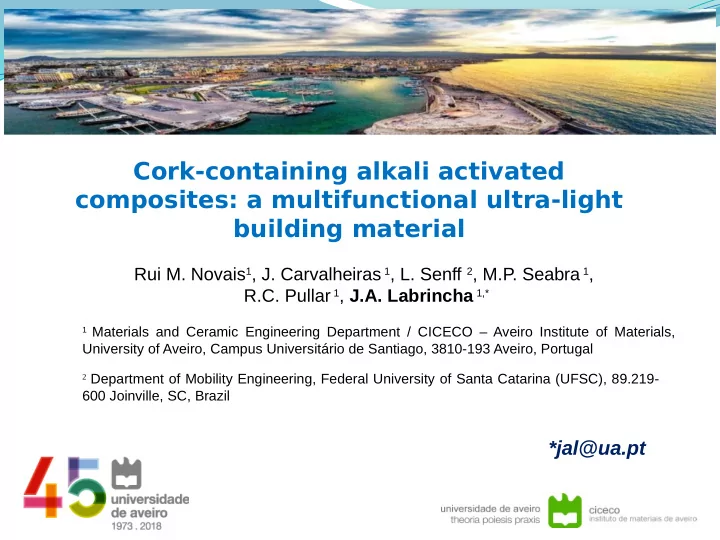

Cork-containing alkali activated composites: a multifunctional ultra-light building material Rui M. Novais 1 , J. Carvalheiras 1 , L. Senff 2 , M.P. Seabra 1 , R.C. Pullar 1 , J.A. Labrincha 1,* 1 Materials and Ceramic Engineering Department / CICECO – Aveiro Institute of Materials, University of Aveiro, Campus Universitário de Santiago, 3810-193 Aveiro, Portugal 2 Department of Mobility Engineering, Federal University of Santa Catarina (UFSC), 89.219- 600 Joinville, SC, Brazil *jal@ua.pt
Geopolymers – current and future Context trends Common Novel uses ? applications Porous geopolymers for innovative applications 2
Ongoing work… Adsorbents Dyes Heavy metals 3D printing pH buffering material Magnetic geopolymers 3
Our geopolymers are on the Cover of Materials Today (Vol 23 , March 2019, p. 105-106) DOI: doi.org/10.1016/j.mattod.2019.01.014 4
Objectives Production of multifunctional cork- geopolymer composites Recent papers from Novais et al. : Cement and Concrete Composites, 97 , 107-117, 2019. Materials Today 23, 105-106 (2019). Journal of Cleaner Production 220C, 630-641 (2019). Journal of Cleaner Production 227, 877-889 (2019). Cement and Concrete Composites 97, 143-153 (2019). Applied Clay Science 179, 105147 (2019). Journal of Cleaner Production 207C, 350-362 (2019). Materials Letters 236, 644-648 (2019). 5
Cork is the Bark of a Slow Growing Oak ( Quercus Suber ) from the Mediterranean Bark is harvested every 9-13 50% of all cork comes from years, but tree lives on Portugal unharmed as carbon sink for 6 >200 years.
Cork is a Renewable Portuguese Resource Cork has a natural 3 Dimensionally Ordered Macroporous structure (3-DOM), hexagonal in radial direction and rectangular in others Silva et al. , Int. Mater. Rev. 53 , 345-365, 2008. Cork is also very light (up to 0.120 g/cm 3 ), presents low thermal conductivity and high sound absorption. 7
Metakaolin and cork characterization Black expanded cork Metakaolin granules SEM/EDS (Argical M1200S, Univar) Mean particle size: ~ 5 µm SSA (BET): ~ 25 m 2 /g Apparent density : 70 kg/m 3 Average size : 5.7± 1.1 mm 8
Cork-geopolymer composites characterization Microstructural analysis 9
Cork-geopolymer composites characterization Microstructural analysis 10
Cork-geopolymer composites characterization Microstructural analysis interfac e X aggrega matri te x There isn’t any clear gradual transition between the dense matrix and the porous aggregate. 11
Cork-geopolymer composites characterization Apparent density Ultra-lightweight composites: 260 kg/m 3 Novais et al. , Cement and Concrete Composites, 97 , 107-117, 2019. The cork-geopolymer composites apparent density is among the lightest ever reported for geopolymer composites! 12
Cork-geopolymer composites characterization Mechanical strength and thermal stability 13
Cork-geopolymer composites characterization Thermal conductivity Low thermal conductivity composites: 72 mW/ m.K 14
Cork-geopolymer composites characterization Moisture buffer value (MBV) Novais et al. , Unpublished results. 15
Cork-geopolymer composites characterization Acoustic insulation Novais et al. , Unpublished results. Collaboration with: Ana María Lacasta (Universitat Politècnica de Catalunya) 16
Conclusions Cork, an extraordinary renewable resource, was used for the fjrst time as lightweight aggregate to produce multifunctiona l cork- geopolymer composites showing: ultra-low density (260 kg/m 3 ) low thermal conductivity (0.072 W/m K) good humidity regulation ability (MBV = 1.64 g/m² ∆%HR) high acoustic absorption ( α = 0.6-0.85 (1600-3200 Hz)) This novel and sustainable material may decrease the energy losses inside buildings, decrease energy consumption and enhance the interior acoustic comfort for inhabitants. 17
Thank you for your attention! jal@ua.pt 18
Recommend
More recommend